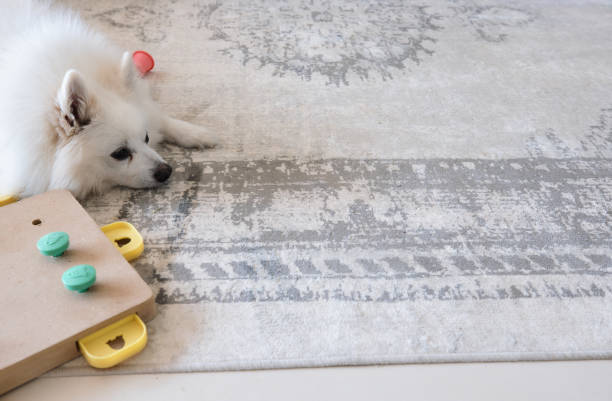If you are traveling and a house-sitter is in charge, the stress of your absence could lead to accidents.
Accidents can happen to your puppy or older pet.
Accidents happen.
This can be a blessing if you have an inexpensive tufted carpet. It protects a more valuable hardwood floor beneath it.
Accidents can be expensive when it comes to oriental rugs (hand-woven). Pet urine is one of the most hazardous spills on textiles.
Cotton is the most common foundation fiber for woven rugs. Wool fibers are then tied around cotton warps. Pet urine, vomit, or poo will penetrate the wool fibers because it is warm and acidic. The cotton fibers will absorb the accident. The accident you see may only be the tip of the iceberg.
In the middle of all rugs, you will find a more significant problem than what is visible on the surface. If you clean an area and it still smells bad, you can’t reach the source of the situation without full immersion cleaning.
When you see an accident, you should act immediately. The fiber protector applied to your rug when you bought it will not make it bulletproof, but it can help stop permanent stains and allow the spills to be held in place for a little longer, giving you a better chance at cleaning it up. The stain must be professionally cleaned if it is left for too long. However, wool and silk rugs that have been protected will clean up much better than those without protection.
Attention: If you are unsure if your rug is real or artificial silk (Viscose Rayon Bamboo Silk, Banana Silk, Art Silk, Manmade Silk Tencel), these are all regenerated cellulose fibers. The fiber is made from wood pulp and cellulose waste products chemically treated to produce a soft, shiny fabric.
All wet spills can be a disaster with these artificial silk fibers. Ask the rug manufacturer for specific instructions on how to care for these fibers. Most accidents will require the rug to be replaced. A simple water spill can cause a rug to be destroyed.
Here are the steps to clean up your wool spills:
If you can, scoop anything up. Use a white cotton towel to blot up any messes.
Pour some soda into a container (or, if you don’t have soda water, a mixture consisting of white vinegar mixed with three parts cool filtered water). Then, wring the excess water out and DAMPEN affected area. After blotting with a cotton cloth, remove any urine, vomit, or fecal matter. Blotting can help prevent pile damage or distortion. Scrubbing may damage lower-quality wool.
Blot the area until there is no more liquid in the towel and it remains damp. Place a cotton towel folded in half under the rug and another over it. Press the towel down into the rug by placing the weight on the spot. The towel underneath the area is to protect the floor. The towel on top is intended to receive moisture.
Weight will create a capillary effect where moisture from the rug fibers moves UP and into the white, dry cotton towels. This will also help move contaminants with the moisture. The “loose dye” will also move into the towel and not outward to other areas of your rug.
The towel should be left in place for at least one night. The wicking process will be more effective if there is no movement. I use a small kettlebell for that weight, as it won’t move unless you do. You can stack books or any other weight of 5 pounds or more on a tray.
Warning: Stop immediately if you notice the rug dyes transferring to the towel while blotting. You should also dry the area quickly. CORN STARCH can be used to absorb moisture. If you pack the area in powder and take the rug to an expert rug cleaner as soon as possible, the damage will be minimal. If your rug is silk, you’ll want to immediately blot the spill and cover the area with CORN STARCH. Most silk dyes will bleed fairly quickly, so it’s better to be safe than sorry.
You do not want the back of any rug to be wet. You are adding too much moisture to the foundation of your rug, which could lead to mildew or dry rot.
Pet accidents can cause a lot of damage to rugs. The stains are permanent, the smell is strong, and long-term exposure causes bacterial and fungal contamination in the middle of the carpet. This is not good for your indoor living environment.
Removing urine from these rugs must be completely submerged in a rug-washing facility. The rug must be thoroughly cleaned and decontaminated.
The rug’s surface is only cleaned when you clean it at home. The top of the fibers are cleaned, but the fibers inside remain contaminated. Because of this, they may still have a strong smell even after cleaning at home. This process DOES NOT remove the source of contamination, which is located in the middle part of the rug.
Only a thorough wash will allow you to reach the root of the problem.
You can buy inexpensive synthetic rugs and cover your valuable rugs or swap them to eliminate the risk.

